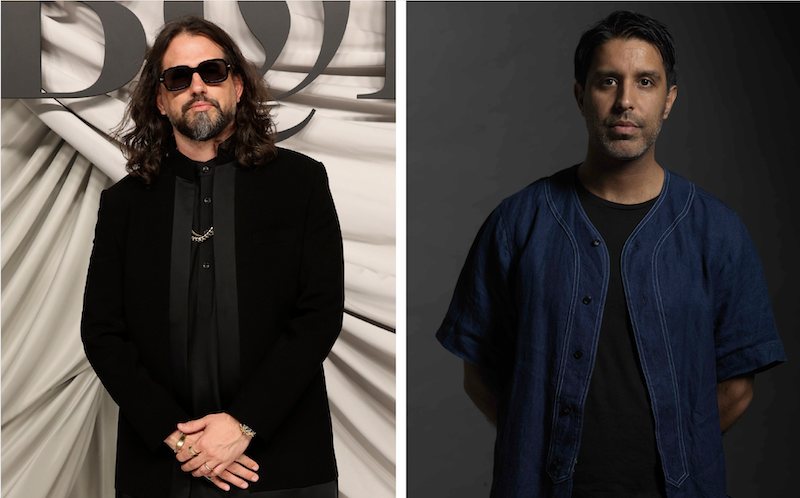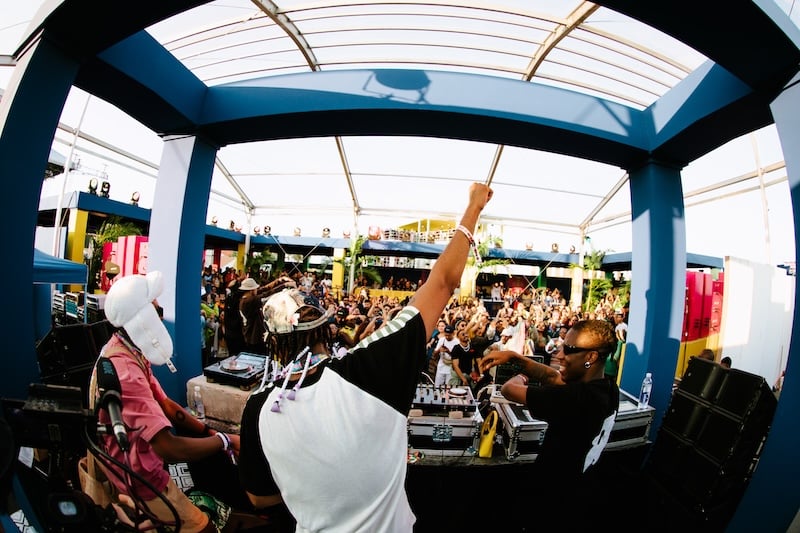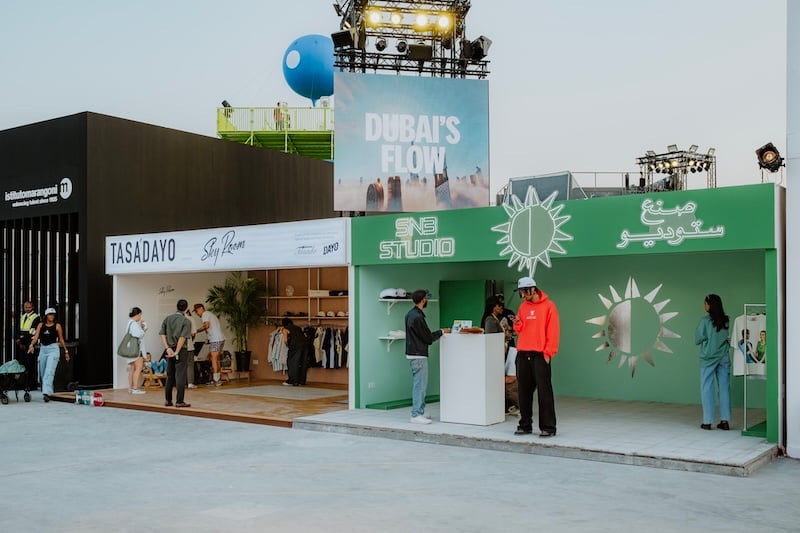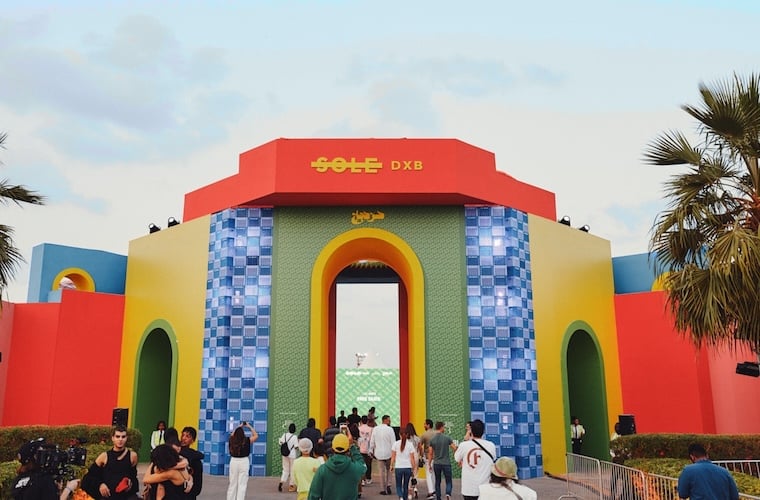This year, Sole DXB will once again take place at d3 on December 13 to 15, 2024, with the support of Dubai Calendar and Dubai Design District.
The 12th edition promises diverse offerings and elevated experiences with new stages, extended hours and a dynamic lineup that blends iconic artists and groundbreaking talent across music, fashion, visual art and more. Established in 2012, much of Sole DXB’s revere is in the physical design, impressive line-up of homegrown and international brands and artists across industries, and unique activations. Over 12 years, the festival have consistently upped the ante in curating and delivering experiential spaces, paving the way for starting entrepreneurs and creatives within the region to be introduced to a larger audience, and eventually cementing its reputation as a major cultural destination in the Middle East.
Here, disruptors and Sole DXB masterminds, co-founder Joshua Cox and partner Rajat Malhotra, share their early beginnings, remarkable milestones, how they are navigating expansion while remaining authentic to its founding values.

Tell us about your career journey.
Joshua Cox (JC): Having been raised in Dubai, I studied industrial design abroad and returned at a time when there were only very typical opportunities for “creatives” in what I considered traditional agencies or architectural industries. So, I looked to carve out my own space in my home city. I co-founded Sole DXB along with my partners while also partnering in another multidisciplinary design studio. As we all had “day jobs,” it allowed us to build something different. Sole DXB was created with a big vision for the future. It wasn’t driven by the commercials but was a needed creative outlet for us and the city.
Raj Malhotra (RM): After university, I started as a volunteer teacher at a non-profit programme in New York. I had grown up in Kuwait, so eventually I decided to come back to the region to explore opportunities for work and moved to Dubai, in 2004. At that time, I was traveling and doing project management work between Tunisia, Algeria and Iraq. I eventually got into the telecom infrastructure business and did that for 8 years across some pretty interesting countries. In 2013, I decided I was going to take a sabbatical, but just as I was going to do that, I met Josh and Hussain, my partners today and my career took a very different path.
How did you end up establishing Sole DXB? What are some of your early experiences that have shaped your vision for Sole DXB?
JC: Dubai is a place where third-culture expats like myself thrive and are in numbers. Its nature fosters a belief in cultural exchange. However, when we started this journey in 2010, there were sides of this city that were being overlooked. Long story short, after some chance introductions and connections, over a dinner that started mostly with complaining about the lack of spaces for arts and culture, by the end of that dinner, we decided to create a platform for like-minded individuals and bring them together.
RM: Sole was actually started by Josh, Hussain and Kris. I met them a couple of years after they had launched the platform online and hosted a couple of events in Al Quoz. I had an avid interest in visual art and initially our conversation was to work together in that space, but there was a trip we all took together to London to get away for a bit and get to know each other better, and when we came back, they had kindly asked me to come on board as a partner in the business. The early days were pretty wild for us. The city didn’t really have anything that looked Sole DXB and so we just had to do our own thing and trust our instincts and try and build the show as honestly as possible, programming an experience that was true to what we were about.
You both wear many hats. How would you describe what it is that you do as Sole DXB Partners?
JC: While we jointly share in the business management and development, my role is mainly responsible for concept and experiential elements of the business. This includes brand curation and integration. The elements of this role range from finding authentic connections between our audience and brands to our own project presentations at the festival and year-round. In a nutshell, I am responsible for the physical manifestation of our ideas and the festival itself—from concept and design to build and execution.
RM: We’re a pretty small team, so we do wear a lot of hats…it’s probably helped us learn our business a lot better, we do have areas we focus on though. Josh looks after production and experience, focusing on bringing our brand to life in the real world. Hussain has always translated our brand into the visual design world through print and digital, and a lot of that spills over into the venue as well. I’ve focused on talent and programming and bringing together a mix of creators from around the world to represent our brand story in any given year.

What are the key pillars of Sole DXB that shape it as a brand, and how do you translate that vision into something consumers can experience?
JC: Music, art/design, fashion, sport, and sustainability are our main pillars. But in the wider sense, essentially elements of contemporary lifestyle are arts and culture. Our role is to create the right mix of elements that form an environment for people to bring their best energy. While we’re proud of the show we built, it’s our crowd that makes it an experience you don’t want to miss.
RM: Our key pillars have always been music, fashion, visuals arts and sports. After Covid-19, we added wellness as a fifth pillar as well. Sole DXB isn’t a static entity. It’s a reflection of our team’s journey and our partnership. As we learn and evolve, the show evolves with us. We do sweat the details. Everything is considered. But mostly, we just put on the things we like and we try and work with people whose work we admire.
View this post on Instagram
What are you looking forward to this year – what’s a highlight that one can’t miss?
JC: The music lineup this year as a whole— Raj really managed to put something special together. A lot of these acts we’ve been working on for a while, so it’s exciting to see them on our lineup. In terms of the space, we’re trying a different format and have a new elevated grandstand and a second stage. We’re also excited about our brand mix; we have a wide representation of brands from across our region,
View this post on Instagram
How do you discover artists and creatives you’d like to work with?
RM: We’re constantly traveling. We’re constantly listening and watching. We’ve met so many incredible people from around the world that send us what they’re being exposed to as well. The discovery is half the fun. You have to be able to keep an open mind to everything and try and go see art in the context it was created for. Go meet people where they are and see what they’re about.
What are some of the biggest shifts you’ve seen in the streetwear space? Have any of these changed the way you approach when working on the festival?
JC: I think what was once streetwear is now just contemporary fashion; we never necessarily saw it as compartmentalized as that. We have always had a crossover—we’re just now seeing that shift generationally. So while we don’t draw within predefined lines, we have to trust our own taste and sense of what feels right. It’s not an exact science.
RM: It’s hard to comment on the term streetwear, because today it mostly just means T-shirts and hoodies and so it’s become pretty commoditised. But the idea that fashion is a means of self expression or a way to identify with a community will never go away. There are so many new ideas coming out that are engaging and thoughtful and those designers are building their own audiences. That’s what we’re interested in…
What role does Sole DXB play in the wider cultural landscape in UAE?
JC: I like to think we have made our mark. For me personally, it’s been the stories of inspiration or connection that have nurtured opportunities that didn’t exist for myself or my peers growing up in this city. Whether that’s simply being inspired to follow your creative passion, to launch a label, or to become a DJ. But moreover, I think we show a different side to the city that allows people to imagine a pursuit and contribution to the arts while making Dubai home.

RM: Our mission is to improve the quality of life in the city through arts, culture and sports. We’re privileged to work in a space that we love and we recognize that comes with the responsibility to contribute, create and support the next generation of creators that are coming up. We would like to think we’ve played a role in framing a point of view on this global culture from our region. We also would hope people feel that we’ve made the city more livable and given them spaces to be themselves and meet and discover other people like them.
Sole DXB has become a destination for luxury and under-the-radar brands to further expand their cultural calendar. How do you look at that and how do you think it affects Sole DXB at large?
JC: We have personally been in the rooms and on calls to champion that fact. Our show was one of, if not the first, to have luxury brands like Dior, Gucci, Kenzo, and Burberry in the same environment as lifestyle and independent brands. We were also the launch/drop pad for a lot of firsts or brand exclusives, product activations, etc. As that grows, we hope that brands look to invest more into the culture of the region and treat our audience with the same priority as other markets.
RM: We often see brands as shop fronts and logos, but there are real people behind them. Someone, somewhere decided they wanted to start something new and they had a reason behind it. Sole DXB is where you come to tell people what that reason is. Working with the people behind those brands has helped us broaden our reach and create diverse programming.

What are some of the things that excite you about the future that relates to further solidifying Sole DXB?
JC: I think it’s less about streetwear and more about how we can improve the city for ourselves and our communities—where we can bring arts, entertainment and education.
What is the most important lesson you’ve learned since you launched Sole DXB?
JC: It’s been over a decade, so it’s not a single lesson but rather a shaping of the kind of leader I want to be and the kind of business we want to build. A lot of the time, we were told, “It’s not that simple,” or, “It’s just business,” and were expected to settle for the status quo.
RM: I’ve learned the value of simplicity and clear thinking.
Does the brand mean something different to you now than it did when it launched in 2011?
JC: In some ways, yes. We’re still the curators and responsible for creating the environment for that, but it’s exciting to see our region and our peers growing with us and in their own right. It keeps it interesting because you never know what to expect, and we look forward to continuing that journey.
RM: As we’ve grown, we feel it’s come with more responsibility, but the fundamentals remain the same: We do this for the journey with each other as partners and hopefully that chemistry creates joy for our community and fans.
– For more on how to look smart and live smarter, follow Emirates Man on Facebook and Instagram
Images: Supplied











